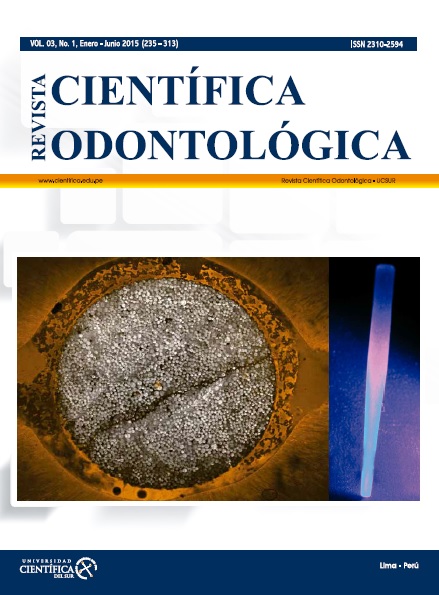Resistencia a la flexión de resinas acrílicas termopolimerizables usadas en la fabricación de prótesis totales
DOI:
https://doi.org/10.21142/2523-2754-0301-2015-280-287Keywords:
Resina Acrílica, Resistencia Flexural, DenticiónAbstract
OBJETIVO: Evaluar la resistencia flexural de cuatro resinas acrílicas termopolimerizables utilizadas en la fabricación de
prótesis totales.
METODOLOGÍA: Se elaboraron 42 láminas de 3mm de espesor, 60mm de largo y 10mm de ancho, fueron todas procesadas
de acuerdo a las indicaciones del fabricante, así como estandarizadas con un calibrador pie de rey electrónico; pulidas y
abrillantadas de una sola cara y luego almacenadas en agua destilada a temperatura ambiente por dos semanas. Finalmente
fueron sometidas a pruebas de flexión sobre el émbolo de carga de 500 Kg a una velocidad de 5mm ± 1 mm/min. Los resultados
se evaluaron con las pruebas de ANOVA y Tukey (p<0.001).
RESULTADOS: La que alcanzó mayor resistencia flexural fue la resina acrílica EZ CRIL con un promedio de 94.36 ± 5.53
MPa, VIPICril PLUS (VIPI) y Triplex Hot (Ivoclar) alcanzaron valores de 89.17 ±7.06 MPa y 87.85 ± 8.67 Mpa respectivamente,
la que obtuvo menores resultados fue la resina acrílica IVOCAP con un promedio de 81.34 ± 5.72 MPa. Se encontró
diferencia estadísticamente significativa, evaluada mediante la prueba de ANOVA (p<0.001). Mediante la prueba de comparaciones
Múltiples de Tukey se encontró que los únicos dos grupos que muestran diferencias significativas son el grupo de
IVOCAP y EZ CRIL con un valor de p < 0.001,
CONCLUSIÓN: La resina acrílica Ez Cril (New Stetic) presentó mayor resistencia Flexural en comparación con las otras
resinas acrílicas; sin embargo todas las resinas acrílicas evaluadas alcanzaron valores superiores a los que la norma ISO 1567
recomienda.
Downloads
References
Steenbecker O. Principios y bases de los biomateriales en operatoria dental estética adhesiva. Valparaiso Chile: Universidad de Valparaiso; 2006.
Zarb GA, Bolender CL, Carlsson GE. Boucher’s prosthodontic treatment for edentulous patients, 11th ed. St Louis: Mosby; 1997. p. 337-42.
Kenneth J. Ciencia de los materiales dentales. 11a ed. Madrid: Elsevier; 2004.
Takamata T, Setcos JC. Resin denture bases: Review of accuracy and methods of polymerization. Int J Prosthodont. 1989; 2: 555-62.
Kimura H, Thraoka F, Ohnishi H, Sano T. Applications of microwave for dental technique (Part 1). Dough-forming and curing of acrylic resins. Journal of Osaka University Dental School. 1983:23-43.
Ramírez AP, Guillén LF, Cifuentes HG. Comparación de la resistencia flexural de dos resinas acrílicas termopolimerizables (convencionales y de alto impacto). Rev. Colombiana de investigación en odontología.
; 3(8): 106-13.
Oliveira A. Flexural and fatigue strength or chemically activated resin in association with an hybrid fibre. Biosci. J.2004; 20 (2): 103-12.
Konchada J, Karthigeyan S, Asharaf S. Effect of Simulated Microwave Disinfection on the Mechanical Properties of Three Different Types of Denture Base Resins. Journal of Clinical and Diagnostic Research.
; 7(12): 3051-3.
Gharechahi J. Flexural Strength of Acrylic Resin Denture Bases Processed by Two Different Methods. JODDD 2014; 8 (3): 148-52.
Smith DC. The Acrylic denture base: Mechanical evaluation of dental polymethyl methacrylate. Brit Dent J. 1961; 4: 9-17.
Kelly EK. Flexure Fatigue resistance of heat curing and cold curing polymethyl methacrylate. J Am Dent Assoc. 1967; 74:1273-6.
Beyli MS, Von Fraunhofer JA. An analysis of causes of fracture of acrylic resin dentures. J Prosthet Dent. 1981; 46:238-41.
Shen C, Colaizzi FA, Birns B. Strength of denture repairs as influenced by surface treatment. J Prosthet Dent. 1984; 52:844-8.
Manley TR. Dentarure bases reinforced with carbon fibers. Brit. Dent J. 1979; 146(1): 25-9.
Schreiber CK. Polymethyl methacrylate reinforced with carbon fibres. Brit Dent J. 1971; 130: 29-30.
Lee HH, Lee CJ, Asaoka K. Correlation in the mechanical properties of acrylic denture base resins. Dent Mater J 2012; 31:157-64.
Grajower R, Goultschin J. The transverse strength of acrylic resin strips and of repaired acrylic samples. J Oral Rehabil. 1984; 11: 237-47.
Jagger RG. Effect of the curing cycle on some properties of a polymethyl methacrylate denture base material. J Oral Rehabil. 1978; 5: 151-7.
Harrison A, Huggett R. Effect of the curing cycle on residual monomer levels of acrylic resin denture base polymers. J Dent. 1992; 20: 370-4
John J, Gangadhar SA, Shah I. Flexural strength of heat-polymerized polymethyl methacrylate denture resin reinforced with glass, aramid, or nylon fibers. J Prosthet Dent. 2001; 86(4):424-7.
Ander P, Sonnesa J. Principios de Química. Introducción a los conceptos teóricos. México: Limusa; 1979.
Rosen SL. Fundamentals and Principals of polymeric materials. New York: John Wiley and Sons; 1982.
Macchi RL. Materiales Dentales. 3 ed. Buenos Aires: Ed. Médica Panamericana; 2000
Ng ET, Tan LH, Chew BS, Thean HP. Shear bond strength of microwaveable acrylic resin for denture repair. J Oral Rehabil. 2004;31: 798-802.
Rached RN, Powers JM, Del Bel Cury AA. Repair strength of autopolymerizing, microwave, and conventional heat-polymerized acrylic resins. J Prosthet Dent. 2004; 92: 79-82.
Arioli JN, Butignon LE, Pereira RP, Lucas MG. Flexural Strength of acrylic resin repairs processed by different methods: water bath, microwave energy and chemical polymerization. J Appl Oral Sci. 2011;
(3): 249-53.
Banerjee R, Banerjee S, Prabhudesaj PS, Bhide SV. Influence of the processing technique on the flexural fatigue strength of denture base resins: An in vitro investigation. Indian J Dent Res. 2010; 21(3): 391-5.
Downloads
Published
Issue
Section
License

Este obra está bajo una licencia de Creative Commons Reconocimiento 4.0 Internacional.












